A reader by the name of Theodore asked a question about the ending to Castlevania II for the NES:
In Castlevania II: Simon’s Quest, the text in the three endings doesn’t seem to match up with the visuals or how you get them.
The worst ending (that you get by taking the longest) shows a black and white picture with Simon gone, but the text is the most upbeat of all three endings. On the other hand, the normal ending has a full-color picture with Simon, but the text says that Simon died, which seems to match better with the worst ending. The best ending doesn’t have any obvious problems, but the text for the worst ending seems to match it better.
Since Castlevania II had a rough translation already, some people have suggested that the text for the three endings was mixed up — the worst ending got the text that was supposed to go with the best ending, the normal ending got the worst ending’s text, and the best ending got the normal ending’s text. Can you compare the American endings to the Japanese endings to figure out if this is true?
I had considered covering the topic of the endings when I did my Castlevania II AVGN article a while back, but since the endings barely came up in that video I thought I’d save it for later. And now is later, so let’s take a quick look!
First, you might be surprised to know that the Japanese ending is in English!
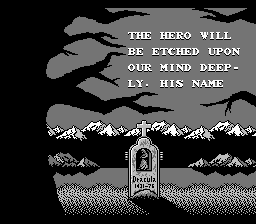 | 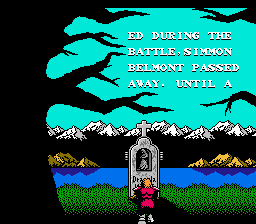 |  |
| Bad Ending | Normal Ending | Good Ending |
It’s clear that the actual English version of the game has at least changed the text:
 | 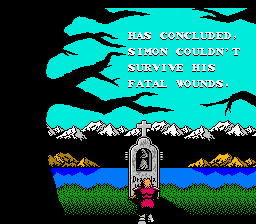 | 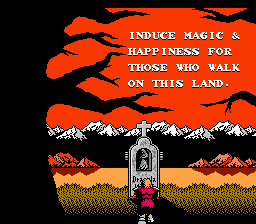 |
| Bad Ending | Normal Ending | Good Ending |
Here’s the full text, side-by-side for comparison:
Bad Ending:
| Japanese Release | English Release |
| And the battle ended. | The battle has consummated. |
| Now the peace and calm have arrived back at Transylvania just live before. | Now peace and serenity have been restored to Transylvania and the people are free of Dracula’s curse forever. |
| The name of the hero will be etched upon our mind deeply. His name is Simmon Belmont, that is the name of yourself. | Simon Belmont will always be remembered for your bravery and courage. |
Normal Ending:
| Japanese Release | English Release |
| And the battle ended. But on account of the injury suffered during the battle, Simmon Belmont passed away. | Although the confrontation between Simon and Dracula has concluded, Simon couldn’t survive his fatal wounds. |
| Until a young man to fight against evils like him comes again to this world, Transylvanians will keep praying forever. | Transylvania’s only hope is a young man who will triumph over evil and rid the city of Dracula’s deadly curse. |
Good Ending:
| Japanese Release | English Release |
| And the battle ended. | The encounter with Dracula is terminated. |
| Simmon Belmont put an eternal period to the legend of Dracula. | Simon Belmont has put an end to the eternal darkness in Transylvania. |
| His blood and sweat penetrated into the ground of Transylvania will bring us full-blown flowers with happiness in next spring. | His blood and sweat have penetrated the earth and will induce magic & happiness for those who walk on this land. |
Both good endings end with this little surprise!
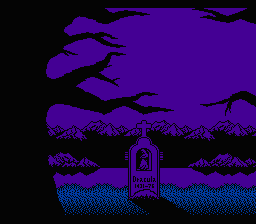 |
Text-wise, it seems like the English game matches the Japanese game, just with improved phrasing, so it doesn’t seem to me to be a translation/localization problem. I’m confused as to why Simon (I assume it’s Simon) appears at the grave in the normal ending, though. The only thing I can think of is that the orange screen was meant for the normal ending and the blue one was meant for the good ending, but the developers messed up and never fixed it… but that doesn’t explain why Simon is still there in both endings. Hmm.
Anyway, if anyone else has any thoughts or insight on this, please share it in the comments!
Also, credit for these screenshots goes to the splendiferous VG Museum. You’re such a great resource, thanks a billion!


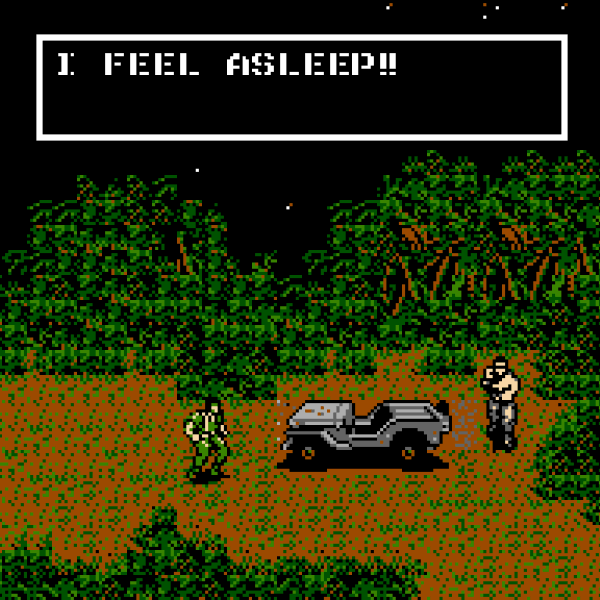
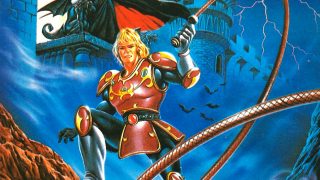

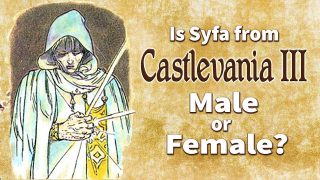
My guess is that Simon dies no matter the ending and the person who appears in normal and good ending is someone else.
I was always confused as to why Simon would pay respects to the grave of the enemy of all humanity, never mind someone else who didn’t participate in the battle against him. I get that it’s a respect thing, but surely he would have been joined by others if it was this big a deal.
no, he only dies in the bad ending. the character kneeling is obviously simon. he broke the curse
So, he died after the normal ending, is what you’re implying.
It’s odd that the text of the bad ending is so positive for a bad ending, especially compared with the normal one. Maybe it’s to hide the existence of the other endings. Someone, who only ever got the bad ending might never even consider that there are others, since this one is pretty satisfactory (for a NES game). Maybe, the mere existence of the multiple endings was a secret that has to be discovered (something I wouldn’t put past such an old game, especially a rather obfuscated one like Castlevania II).
Of course, I don’t know how upfront the game is about it’s multiple endings, in the first place. Like, if it’s mentioned in the manual or so.
> and the people are free of Dracula’s curse forever.
ha ha…
Yeah free forever… and a Second later you See draculas Hand
I wonder what they were thinking when they changed the text for the English version? It isn’t much better and is even worse at times.
It rally puzzles me who translated this game in the first place. The English is pretty spotty, so it clearly wasn’t a native English speaker, but there are several outright mistranslations throughout that makes it hard to believe the translator’s Japanese was all that good either.
That last line of the best ending in the original text is very Japanese.
Prior to Dracula’s defeat, Transylvania had to suffice with half-blown flowers.
I dunno, did it occur to anyone else that maybe the original developers got the text messed up? especially if they didn’t know English very well, they may have made a mistake and not realized it.
Yes and i guess the translators just did their work and didnt Really Play the Game. So they didnt notice that the Text wouldnt fit the images
I’m pretty the scene with Dracula’s hand only appears in the best ending, at least in the NES version (I can’t speak for the FCD version). Also, the person kneeling in front of Dracula’s tombstone is clearly Simon. He matches Simon’s character design in the game sprite and packaging illustration.
Yeah, the hand only appears in the good ending for both versions of the game.
Richard Simmons Belmont.
I couldn’t help pronouncing “Simmon” the same way. xD Thanks for turning it into a pun for me!
I think it’s actually meant to be pronounced that way. It’s mentioned in the comments of another Castlevania post.
Is it possible that the difference in the endings is _when_ Simon dies? It never occurred to me that the game’s ending texts were mixed up. Instead, I thought up the following conjecture:
The reason that Simon must take this quest in the first place is the curse that Dracula cast on him which keeps the wounds he suffered in that battle from healing (and why I think he wears the red and black outfit that covers his entire body instead of one that shows a large amount of skin like in the first game). He waits 7 years after the events of the first game before he decides to take action.
Throughout the game, Simon knows that 1698 will be his last year alive if he does not hurry. The distinction between the endings is in how much blood leaks out through his still-open wounds. His curse becomes terminal if he takes longer than 7 days (from good ending to neutral ending), and its progression accelerates if he takes longer than 14 days (from neutral ending to bad ending).
In the bad ending, Simon dies before he has time to visit Dracula’s grave; maybe shortly after he deals the final blow. His death is merely implied by his absence from the scene, not outright stated.
In the neutral ending, Simon is visible in the scene, but the text describes events in the near future (or that the scene with Simon at the grave is in the past compared to the text), which means that Simon lives for a little while longer than he does in the bad ending, but does not get to live a long life and go into retirement. Because Simon is visible, the text has to state directly that he will die.
In the good ending, Simon’s curse is broken in time for his body to heal just before his curse becomes terminal.
It did bug me, however, that the bad ending’s text seemed more upbeat than would be expected for a bad ending, but I blamed poor translation for that. However, I do believe it more likely that the texts were mixed up as described in the article, which would mean that Simon lives a long life in 2 endings instead of 1 ending.
I agree with your analysis. But It doesn’t bug me that the bad ending is more upbeat, because it is some sort of epitaph. It’s a little bit more upbeat, but I also see the sadness in it. Saying “you will always be remembered” for someone that just died is just a common saying, and for me is pretty sad.
And about the curse that seems to be lifted in the bad ending and not in the normal, and even less in the good ending, I see that like the other games that put a “?” after “the end”.
To know that the fight will continue and that there will be a Castlevania 3 is a reward for the player. So in the bad ending, you have no clue that there will be more games. In the normal ending you have the hope that someone will carry on. In the good ending you know there will be more, and it doesn’t have to be in the text because the hand pops up from the grave.
If you see it like that, it’s normal that the bad ending seems more upbeat, because it’s a closure to the story. And as I said, I don’t find that especially joyful to end on such a note.
i guess its supposed to be like that. In the Bad ending there is no Need to mention that Simon is dead because His abscence shows it. In the normal Ending he lives Long enough to visit the grave but the Text indicates that he will die soon After it. Only in the best ending you live Long enough to See dracula rising again (or at least his Hand) 😉
Was the “just live before” in the Japanese bad ending a typo in the game’s script, or a transcription error on the site?
It’s in the game:
I’m…kinda sad there wasn’t a tool-tip on that image =(
Oops
Worth it ^_^
So, it looks like “Simmon” doesn’t like unfinished sentences.
BLOWN FLOWERS
WITH HAPPINESS
IN NEXT SPRING
.
That period on its separate line was a stroke of genius. 🙂
You say you’re not sure why Simon appears in front of the grave during the normal ending, but I’m not sure why he appears in front of the grave during the good ending.
I realize this is probably a good bit of rationalization (after all, I was very young when I played this game, and CV’s story was far from fleshed out at the time), but I always took it that in the normal ending, he knew he was going to die, and he was praying that Dracula never came back. If you think of it that way, then it makes less sense than he’s there in the good ending. Although… I guess the idea of Dracula staying dead is important no matter what; it just seems more dramatic and desperate to me in the normal ending.
If anyone knows whether or not it had been established that at this early point in the series that Dracula keeps coming back, and that CV2 was about getting rid of Simon’s curse and not Dracula, then it might lend some weight to my shaky rationalization, too!
The story in the manual specifically says that sealing Dracula’s remains in his castle the way you do at the end will permanently destroy him.
The hand at the end is meant as an “oops, guess it wasn’t permanent after all” note, I assume. The first Gameboy game has a similar ending, where we see Dracula in bat form fly out of the castle ruins after the credit roll.
The character who visit Dracula’s grave is definitely Simon.
You can’t be absolutely sure with such severe engrish but in my mind there’s no question about it that the text displayed at the normal ending was meant for the bad ending and vice versa. And I personally think that’s about it.
The text for the good ending is also the only one where it states Simon put an “eternal” end to Dracula so it seems fitting.
I can understand where some may see the good ending actually being a bad one with the hand that reaches up from Dracula’s grave at the end. But it’s just a secret reward for finishing the game under “seven days.” An easter egg or sequel hook – “pure evil never dies.” The basic horror movie cliche. That’s my interpretation of it.
It should also be noted that Dracula is already dead in this game, you are only fighting his spirit at the end in order to get rid of his curse on Simon and Transylvania. When it says, “But on account of the injury suffered during the battle, Simmon Belmont passed away.” They of course refer to the battle in the first game – Dracula’s curse on Simon. Unfortunately you took too long to finish the game so Simon didn’t make it.
I think in retrospect, the perfect title for this game would’ve been Dracula’s Curse, but instead they named the prequel that instead.
““But on account of the injury suffered during the battle, Simmon Belmont passed away.” They of course refer to the battle in the first game – Dracula’s curse on Simon”
– I actually would have never guessed that). This detail was definitely lost in the US translation.
I think originally the bad ending was supposed to play as soon as 15 days have passed, without letting the player finish the game. That’s why Simon never appears in it. Also there would be no ambiguity about which “battle” the text refers to, since the battle in the second game is yet to occur. I believe the ability to finish the game after 15 days was added as an afterthought, hence the confusion. (buuuuut since Bad ending has Normal ending’s text it wouldn’t matter anyway)
“You’re such a great resource, thanks a billion!”
You’re welcome 😛
Well, Simmon might have suffered with his wounds for a while before dying in a hospital bed. That scene in the normal ending could be when he was still alive. I don’t know, I just made it up.
My interpretation is that in the better two endings he remained alive long enough to be at the grave and then died later on. While in the bad he just died right away so he couldn’t visit the grave in the first place.
I don’t know why is the bad ending text positive about it, though, and the middle implying everything ended worse.
“His blood and sweat have penetrated the earth and will induce magic & happiness for those who walk on this land.”
I took that as simply being a figure of speech, as “blood and sweat” is usually a way to describe the hard work one puts into their tasks.
I think that the text is mixed up between bad and normal endings,
while the picture and cutscene is mixed up between good and normal endings.
First, I want to say that until TODAY, I had vastly misunderstood this game’s plot, and now I don’t know where I got the idea. I thought Simon had scattered Dracula’s remains after defeating him in an effort to stop him from coming back, and in anger Dracula cursed all of Transylvania. So, everyone is angry at Simon and expects him to fix it, with the only solution being to reassemble Dracula, defeat him again, and give him a proper burial. I suspect a Strategy guide might have been wrong and attempted to explain the false clues you get from people as they’re lying because they don’t like you. Or maybe that was just my own rationalization as a kid. Serves me right for not reading the game manual! In my defense, each of the game’s English endings reference, “the people are free of Dracula’s curse,” “rid the city of Dracula’s deadly curse,” “the eternal darkness in Transylvania,” and Simon’s death is attributed to battle wounds. Oddly, nothing is clearly said of the curse killing Simon.
Now I have a better understanding of the plot, but that original misimpression may still color my interpretation of this article/debate. Here’s my theory on the endings: they’re exactly what they’re supposed to be, and Simon dies in all of them. You’ll notice that the direct sequel is the first game in the series to feature a different Belmont than Simon. If you think of “good” and “bad” endings in terms of rewarding the player (e.g. Samus’s suit progressively disappearing) rather than what’s good for Simon or the people of Transylvania, then what you have is endings that get progressively more interesting and complex, like so:
Bad: black & white, don’t see the hero, very generic/trite happy ending, no other surprises
Simon’s fate is not clear, though both the Japanese “name … etched” and the English “always be remembered” sort of hint at him being dead.
Overall it’s kind of drab, boring, and leaves things unclear.
Normal: full color, we see the hero, more detailed and specific writing, still no surprises
Simon’s fate is stated outright with very little flair.
It’s nice, and it’s clear, but it’s nothing fancy.
Good: full color with beautiful sunset, see the hero, literally flowery poetic writing with an ironic wink about Dracula being gone forever that leads directly into the “surprise” hand rising from the grave after a nifty transition to the night scene
Simon’s death is tastefully suggested via metaphors, in keeping with the poetic tone.
They’ve pulled out all the stops. We get poetry, a scene transition, and a traditional horror movie end with a last scare to bring us back for more.
So, the endings get better in the sense that the actual ending itself is better as a scene, not in the sense that the story is any different or better for the characters. It’s better from our perspective as viewers, not Simon’s.
As for Simon at the grave, maybe he’s not just paying respects, but rather he had to bury whatever remnants of Dracula were left (even if only ashes) himself, because ain’t nobody else goin’ near that stuff to bury it! After what happened last time, Simon isn’t taking any chances. We’re burying the ring and whatever else we can scoop up with a proper headstone bearing the real life accurate dates of his original life as Vlad Tepes, then we’re gonna kneel down and pray to god that this guy stays dead this time without any complications.
Sidenote, I assume that’s supposed to be Simon at the grave (it is his outfit after all), but I could understand someone thinking otherwise for two reasons. First, as we see this person, the normal ending references someone else in the future rising to face Dracula. Second, I never trust boxart (see MegaMan) and in the game Simon’s hair is black. So, I could see someone playing it and going, “wait, who’s this blond kid?!”